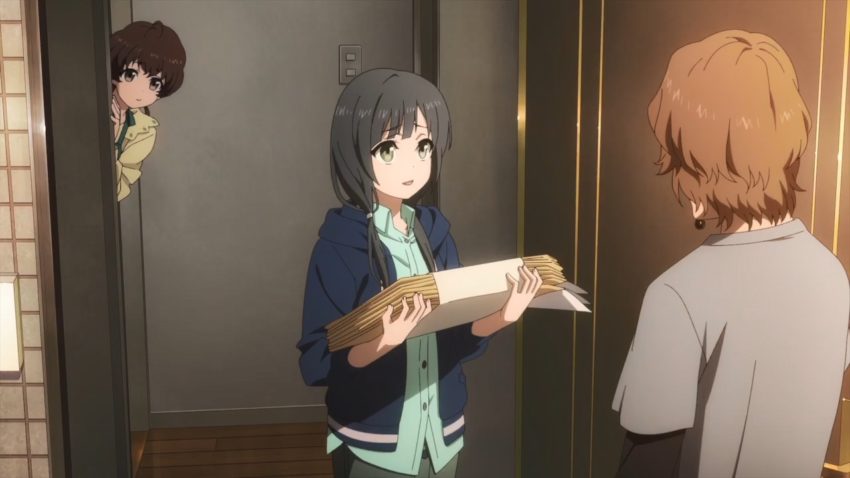Shirobako: The Movie
September 15, 2021 · 0 comments
By Callum May.

Back in the days when Japanese anime creators could hop on a plane to travel the world visiting fans, they were frequently faced with the same question: “How can I join the anime industry?” On the face of it, it’s not strange. After playing Halo 3, I wanted to become a game designer, until I realised programming and art were hard. We all like to imagine that creating our favourite media is as exciting as it can be to consume it. But as we’ve heard through countless reports, both the anime and games industries are far more cruel and exhausting than even pessimists could have guessed.
When I interviewed PA Works president and producer Kenji Horikawa back in 2016, he said that his motivation for creating Shirobako was to explore the reason why anime creators persist within such a harsh industry. At the end of the TV series, the staff at the fictional Musashino Animation managed to create a show that they can be proud of, but in the grand scheme of things, they merely completed a job and had to prepare to take on another. In the film spin-off, screening at this year’s Scotland Loves Anime, this cycle begins anew after a four-year gap, but now taking into account more of the issues the industry faces in the late 2010s.
We first see the main character Miyamori again sleeping at her desk, now serving as producer at a broken Musashino Animation. Unfortunately, this is the most realistic part of Shirobako. During the TV series, with Exodus! and The Third Aerial Girls Squad being produced back-to-back, the production team were able to realistically keep the cast of the show together. But the reality is, that with most creators being freelance, these teams ended up going their separate ways soon after. This is especially true by 2019, where the film acknowledges how busy everyone is due to the industry attempting to fulfill an overwhelming demand for new titles.

This time, the “villains” aren’t a publishing house, but rather another animation studio, GPU. Shirobako has always been full of thinly veiled references to other anime creators and companies, but GPU is more of an amalgamation of all the worst things an anime studio can do. The staff at GPU take on more work than they can actually handle, rely too heavily on outsourcing, and mess up their schedules. Within both the TV series and film, some of the business mishaps are so specific and frustrating that you can imagine they really happened somewhere.
Some of this information may be difficult to keep up with for those unfamiliar with how the industry operates. Each character represents a different role within production and these have changed after the four-year gap. Even those who are familiar with American animation production will be surprised by some of the issues they face. “What’s a production committee?” “Why are they recording the voices now?” “They’re still using paper?” But even if you don’t understand the causes of these issues, it’s easy to understand the effect it has on each of the creators within the story. Producers will get frustrated, directors will get confused, and animators will get burned out. There are even some characters who have left the industry altogether.

Shirobako can be considered as the anime creator’s anime, filled with the knowledge and experiences of the people that created it. In that, it’s already pretty uncommon. Fawlty Towers wasn’t made by hotel owners, after all. And because of this, Shirobako is frequently brought up by others within the industry. Bones president Masahiko Minami has protested that his stern alter-ego “Masahiko Inami” is nothing like him, while Madhouse and MAPPA founder Masao Maruyama once playfully introduced himself at an event with the name of Musani Animation’s president “Masato Marukawa”. Much like the character, Maruyama is also well known for being an excellent cook. While these alter-egos are as much parody as they are homage, there is an effort to reflect the many different ideas that exist within the anime industry. For example, in Episode 6 of the TV anime, a character based on the famous animator Ichiro Itano talks about 3D animation. That dialogue was actually revised and written by Itano himself.
Shirobako has a mixed response to reality. Like many workplace comedies and drama, the goal is largely still entertainment. Most anime is created in small studios and offices, but Shirobako will take any excuse to have creative decisions take place in random places across Tokyo. Likewise, musical numbers and passionate dream sequences are used to break up the constant creative and business discussions. Miyamori even has two imaginary friends who will debate the struggles that come up during work. As the director of real-world popular comedies like Squid Girl and the Girls und Panzer franchise, creating a fun show is Tsutomu Mizushima’s specialty.
The industry can be such a harsh environment that Kenji Horikawa has admitted that they intentionally tried to avoid making the show too realistic, otherwise it wouldn’t be fun to watch. Everyone always says: “You’re so lucky getting paid to do what you love!” But as Shirobako aptly reveals, it’s not about luck, it’s about resolve.
Callum May runs the YouTube channel The Canipa Effect on the anime industry and the talents that make it work. Shirobako: The Movie is screening at Scotland Loves Anime.
Leave a Reply